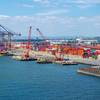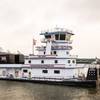Events of the past two years -- headlined by the Asian financial crisis, supported by falling oil demand and punctuated by OPEC's production cutbacks to buoy per barrel pricing -- have conspired to throw and keep the tanker market into a historical abyss. In an industry renowned for its ups and downs, this was a "down" for the record books.
Consequences of poor rates for the transport of oil products have and will be debated for years, but relying on the cliché, "if it doesn't kill you, it will only make you stronger," it would appear that the companies left standing - those not acquired, merged or simply shut down - should be poised to capitalize on favorable market conditions to come. None, though, is so well suited to prosper as Teekay Shipping.
Building the fortress
A quick glance at Teekay's recently released annual report does not immediately give the reader the impression of a company moving forward. Net income, for example, plummeted from $70.5 million in 1998 to $45.4 million in 1999, and the company's operating cash flow per ship day declined from $12,682 to $11,171 in that same period. But alas, numbers alone cannot depict the full scope of Teekay's strengths, as the company has initiated and completed an impressive array of projects -- both inside the company and out -- which are designed to ensure the profitability of the company, in good markets and bad, for decades to come.
Teekay was created in 1973, and currently owns and operates the world's largest fleet of medium-sized (Aframax) oil tankers. Employing more than 2,700 people worldwide, Teekay is well regarded within the industry as a "quality" owner, with a reputation for safety and excellence in transporting crude oil and petroleum products.
The previous year -- barring all other good developments -- was significant for the company in terms of building a long-term powerhouse with its acquisition of Bona Shipholding, a move that significantly expanded the company's operation in the Atlantic Basin. The transaction -- which the company believes was carried out in the low part of the cycle -- created a company that is three times larger than its nearest competitor, and gave Teekay 11 percent of the global Aframax market fleet.
While the Bona acquisition was a significant move that otherwise would have taken many years through natural growth, it was not the only development during the past year, which was designed to ensure the long-term health of Teekay.
Enhanced operating mode
A very basic restructuring of Teekay's marine operations was dubbed "Project Synergy." In short, the move entails the division of the fleet into smaller units, with all aspects managed by a cross-functional ship team, designed to optimize fleet operations and make the company more responsive to customer needs. The ship teams support and are supported by standards and policy teams, which fulfill several critical functions including acting as a center of expertise to the ship teams; ensuring high, uniform standard of operation and driving continuous improvement.
More recently, Teekay has entered into the launch of an innovative marine purchasing cooperative known as MARCAS. In partnership with two other major shipping entities, MARCAS seeks to leverage economies of scale in the purchase of products and services for ships, and in effect creates an entity that buys supplies for 250 ships. Vessel operating expenses totaled more than $84 million, including salaries -- for the company in FY'99, and Teekay anticipates that cost efficiencies through programs such as MARCAS -- particularly with a gradual increase of membership and a widening of the scope of services provided to the organization's members -- will help enhance the bottom line for years to come.
The market
According to Björn Moller, Teekay's director president & CEO, the company expects the tanker market to remain difficult in the near term, but is counting on a medium-term recovery and long-term prospects to buoy the company's financial prospects. In his message to shareholders, Moller notes that global oil consumption is again on the rise, parallel with recovery among the Asian economies, and that oil production is continuing to shift to the Middle East countries. This, of course, is a favorable trend to tanker operators, as it requires longer voyages and greater tanker demand.
Teekay also points to positive trends within the ship supply and demand side that could indicate a strong charge ahead is inevitable. Specifically, much press has been given in the past few years to the "aging fleet," and the replacement requirement of ships sent to the ship breakers. In 1999, the pace of new tanker ordering has slowed considerably in reaction to the poor tanker rates, and Teekay notes that the Aframax tanker orderbook has fallen from 10 million dwt on order in May 1998 (19.4 percent of the Aframax tanker fleet), to 6.3 million dwt, or 11.5 percent of the Aframax tanker fleet just one year later. Enhancing this trend (from the tanker owner's side) is the fact that the rate of tanker scrapping in 1999 is twice that of the rate in 1998, and scrapping is running at its highest annualized level since the mid-1980s. Factors involved in the decision to scrap are numerous indeed, but in general, older ships cost more to keep up, and expenditures of this nature are the first to go in a depressed market. Teekay notes that most crude oil tankers, and virtually all Aframax size tankers, are scrapped previous to reaching 25 years of age. This is significant, as 83.2 million dwt, or 27.6 percent of the current world tanker fleet, will reach 25 years of age in the next four years.
Cumulatively, the above adds up to a rosy tanker rebound in the medium-term. However, it can be assured that when tanker rates start nudging skyward again, plans to scrap older tonnage will be delayed by some, in an effort to extract valuable dollars from older ships before they begin their new life as razor blades. Similarly, the orderbook for tankers will surely rise with freight rates, as owners seek to get new tonnage on-line during the projected run-up.
Sponsored Content
Lower carbon intensity fuels to support your operations

Subscribe for
Maritime Reporter E-News
Maritime Reporter E-News is the maritime industry's largest circulation and most authoritative ENews Service, delivered to your Email five times per week










